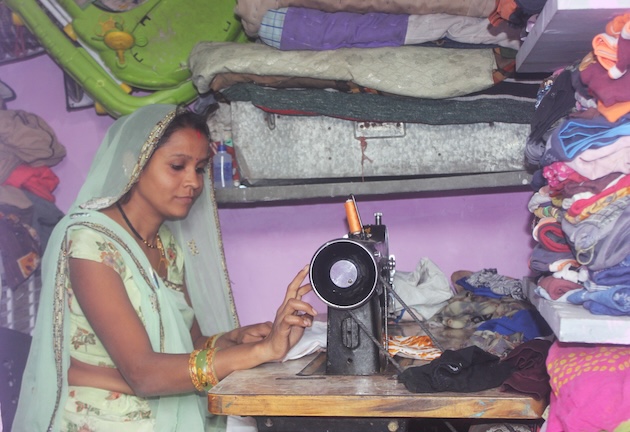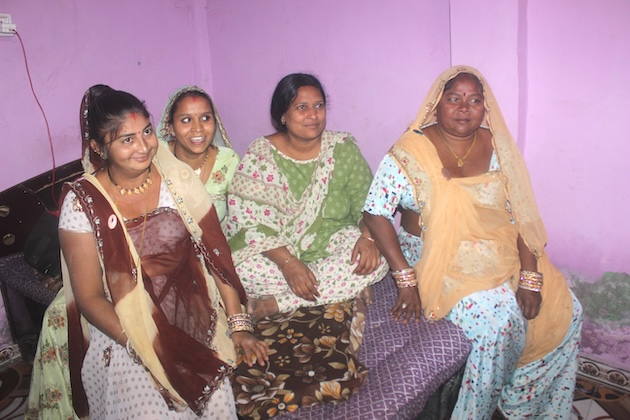AHMEDABAD, India, Mar 18 (IPS) – Women in Ahmedabad slums work from home at tailoring, embroidery, kite-making, snack-making, or running grocery shops, micro-retailing vegetables and flowers, with little respite from the brutal heat waves that have been steadily worsening. Until now…Seema Mali is desperate. She has no defences against this changing climate’s brutal heat. Mali makes fresh flower garland the whole year, but her summer income has been plummeting by 30 percent over the last 8–10 years due to the extreme heat.
India is witnessing record-breaking hot weather in March and May year after year. Last year, 2023, was the second warmest on record in the country since 1901, according to the India Meteorological Department (IMD). The year before (2022) witnessed 280 heat-wave days across the states from March to May, the highest in 12 years. In the beginning of March 2024, IMD has warned India across the States is likely to experience a warmer than normal summer and more heatwave days from March to May.
“Suddenly in 2014, women in 159 urban slums in Ahmedabad that we work closely with flagged extreme heat as their foremost concern. Climate change-related heat, flooding, and mosquito menace shot up over their routine demands for water, toilets, or brick-mortar houses,” Siraz Hirani, senior programme manager at the non-profit Mahila Housing Trust (MHT), told IPS.
Western India city Ahmedabad too saw maximum summer temperatures of 45.8C in 2022. In 2016, a May day’s 48C broke the city’s last 100-year record. May 2010 experienced an unprecedented week-long deadly heat wave touching 46.8C, causing 1344 excess all-cause deaths compared to average May deaths in 2009 and 2011. This propelled Ahmedabad Municipality Corporation (AMC) to come out with a Heat Action Plan in 2013, South Asia’s first.
Women in Ahmedabad slums work in large numbers from home at tailoring, embroidery, kite-making, snack-making, or running grocery shops, micro-retailing of vegetables, flowers, and other businesses. Both their incomes and their presence in the house is critical to the multi-generational families that live together here. Home-based workers account for 18 percent of urban employment in India, according to MHT.
Poorer women in the global south are often facing the brunt of extreme weather, given the high likelihood of working from poorly equipped homes.
Gujarat has 1.68 million people or 1 in every 13 people living in slums. Ahmedabad ranked second-highest in slum population. These latest figures available from the 2011 census are likely to be outdated.
Most, like Seema Mali, who lives in Odni Chawl (Odni refers to scarves Indian women drape over their upper bodies), a squatters’ settlement) where residents live in one-room homes that have no windows, a metal sheet roof and a single ceiling fan that is their only defence against a blazing sun. With hutments crowded together, ventilation in the narrow lanes is non-existent.

So, Who’s Going to Paint the Roofs White?
“Heat solutions were field-tested in the slum settlements. Painting house roofs with white, heat-reflective paint was unanimously voted as the most effective by the women,” said Hirani. Sun reflective paint is a thermally insulating roof coating aimed at reducing the roof temperature.
As MHT arranged funding for the paint purchases, the painting itself would have to be a self-help job. Who would do it? Hired labour would charge INR 500 (6.03 USD), more than the home owner’s daily wages. The menfolk, reluctant to lose a day’s pay doing this, refused to engage.
“We’ll do the painting,” the women stepped up. With a little help, they trained themselves and others to do this supposedly man’s job. They also painted the tin and asbestos roofs of their elderly or sick neighbours.
“Cook our lunch today while I wash and paint your roof is the usual community trade-off amongst our community,” said home-based tailor 28-year-old Nimaben Harishbhai, a community leader, her body language oozing confidence.
Nimaben got a digital room thermometer from MHT installed in her newly white-roofed house and invited community sisters to feel the difference between their bare tin-roof houses and hers. “The temperature was a clear 3 to 5 degrees lower, cooler if ventilation and trees were available,” she told IPS.
Many, like Nimaben, motivated others. The ripple effect was exponential. Today, there are 32,000 cool roofs in city slums that MHT works with. It has trained 14,684 slum women as Vikasini (meaning women who lead development). They are also climate resilience specialists, motivating and leading others, learning from technical experts and partnering the municipality in climate policies for the urban poor.

Losing Work Hours Is Not Happening Anymore After Women Took Matters Into Their Own Hands
“They lost four working hours daily in the summer afternoons due to unbearable temperatures before they opted for cool roofs,” Niruben Badoria, 45, a field organiser with MHT, told IPS. “Higher heat-related medical expenses took away a chunk of their already reduced earnings,” she said.
“Heat cramps, giddiness, and heat stroke cases in extreme events are common,” Dr. Tejas Shah, a medical doctor and Deputy Health Officer at the Ahmedabad Municipality Corporation (AMC), told IPS at his office in southern Ahmedabad. “Worst-affected are outdoor workers, pregnant women, children, and the elderly,” the government officer said.
Dehydration, skin infections, prickly heat eruptions, and urinary tract infections were common, said the majority of Odni Chawl women.
What hurt these women, who put food on the plates of their large families from their same-day earnings, was the loss of daily income.
“For each of us, no matter what profession we worked in, (the difference in) our earnings after and before installing cool roof paint is substantial,” said 35-year-old Seema Mali.
Mali sits cross-legged, surrounded by sunset yellow, bright, and pale-yellow marigolds the size of a baby fist, heaped in bamboo baskets. They are covered with moistened brown jute sacks. She strings them all day into dozens of garlands. By early evening, they’re supplied to temple vendors selling to worshippers.
Mali’s summer income had been plummeting by over 30 percent over the last 8–10 years due to the extreme heat, the home-based worker tells IPS. “With my brother lending a hand, I could earn 10,000 rupees (120.65 USD) in a month from the 20,000 rupees (241.25 USD) worth of flowers I buy as raw material.”
As summer heat rose regularly above 40 °C, income began falling to 7000 rupees (84.45 USD), limiting her ability to buy sufficient raw materials.
“The tin-roofed single room becomes a furnace even before noon.”
Every 30 minutes, she would desperately sprinkle water on the jute sacks, under which she hid the flowers from the heat. By late afternoon, with the combination of heat, water, and high humidity, the receptacle or base of the flower would not hold together when the thick needle pierced it, and the petals fell off.
“The white roof has helped immensely,” Mali said. Income has risen by 15 to 20% compared to when she hadn’t painted her roof. Days are longer in summer and she now converts the extra hours to be more productive.
Encouraged, she now takes even more care. In summer, she is out of her house by four in the morning. In the dark, she heads for the Jamalpur Phool Bazar, Ahmedabad’s largest bulk-sale flower market. By sunrise, she has already weighed, paid for, and brought the two large sacks of fresh marigold flowers indoors before the sun can scorch them.
Nimaben, who stitches ladies’ garments, says she has, on some days, been able to double her income after opting for cool roof paint.
“Earlier in the afternoon, four hours were so hot that I could barely sit for one afternoon hour in my tiny 4×8-foot sewing room. If I hustled household work, I somehow managed to sew one garment that fetched labour charges of 300 rupees (3.62 USD),” said Nimaben, mothering a one-year-old baby. “Now I’m able to work afternoons too, so output is higher,” she said.
“We saved on our electricity bill too,” Nimaben added. She spreads out her power bills on the bed. They reflect a saving of more than 50%. “The portable room cooler is used much less; fans no longer run all day and night and the newly-opened window ensures the light bulb is not burning 15 hours a day,” she explained.
Two years ago, Nimaben and her husband Harishbhai decided to modify their ancestral 50-year-old house for more cross-ventilation as the heat grew extreme. His old parents and their own three children live together. Harishbhai earns 350 rupees (4.22 USD) a day polishing stainless-steel utensils.
They have enrolled their eldest in a private English-medium school, so that he gets “better opportunities in life.”
“We need all the income we can manage, but the heat was stealing a big chunk of our earnings,” Nimaben told IPS. “The white roof has arrested the thief,” she adds, grinning at her own wit.
The other women sitting there nod vigorously in agreement. Her mother-in-law, 60, an outdoor worker who collected old iron rods from house to house, adds that she felt summer heat began increasing perceptibly when she was 35 years old—that is, 25 years back, closer to circa 2000.
Cooling demand in India is projected to grow 8-fold by 2038, and by 2050, it could contribute up to 45% of the country’s peak energy demand, according to Hirani.
Urban Slum Women Turn Climate Champions for Themselves and Their Cities
In 2017, AMC began formulating a cool roof program; among others, it sought input from urban poor communities. Convinced about the effectiveness of the white roofs after visiting MHT slums, the civic body invited the women climate leaders to partner in their heat policies.
By this time, MHT’s Vikasinis had already developed a variety of low-cost, effective solutions. For hot roofs that trapped heat, they came up with modular roofs, cross-ventilated rooms, using natural building materials like bamboo corrugated roof sheets and bamboo mat walls secured on iron frames, using thick layers of creepers to cool tin roofs, as well as thermocol-lined roofing.
“Participation of slum communities is a must for large-scale implementation of cool roofs. The city municipality lacks funds to paint the roofs of millions of slum homes. MHT is doing good work motivating communities to paint their own roofs,” Dr. Tejas of AMC told IPS, suggesting large Indian paint companies need to include cool roofing in their corporate social responsibility (CSR).
Under the federal government’s housing programme for the economically poor, AMC is, however, ensuring Chinese mosaic roof tiling, which also deflects sun rays and is longer lasting.
“For the AMC, its heat policies are mainly focused on health risk reduction,” said Dr. Tejas. The women climate leaders have managed to broaden the policy conversation to include climate adaptation for livelihood protection and overall quality of life in slum settlements.
These women’s cool roof initiatives align with the Indian government’s India Cooling Action Plan (ICAP), which works towards cooling across cross-sectors, including promoting passive cooling in buildings. The plan targets reducing cooling demand by 20–25% and refrigeration demand by 25–30% by 2037.
“After we partnered with the municipality corporation, we gained so much confidence and were able to speak up in front of officers. We are acknowledged. When ‘no objection certificates’ from the municipality office were required to install our electricity meters, I by myself got the work done not only for our house but for others’ too,” Nimaben told IPS.
IPS UN Bureau Report
© Inter Press Service (2024) — All Rights ReservedOriginal source: Inter Press Service
















